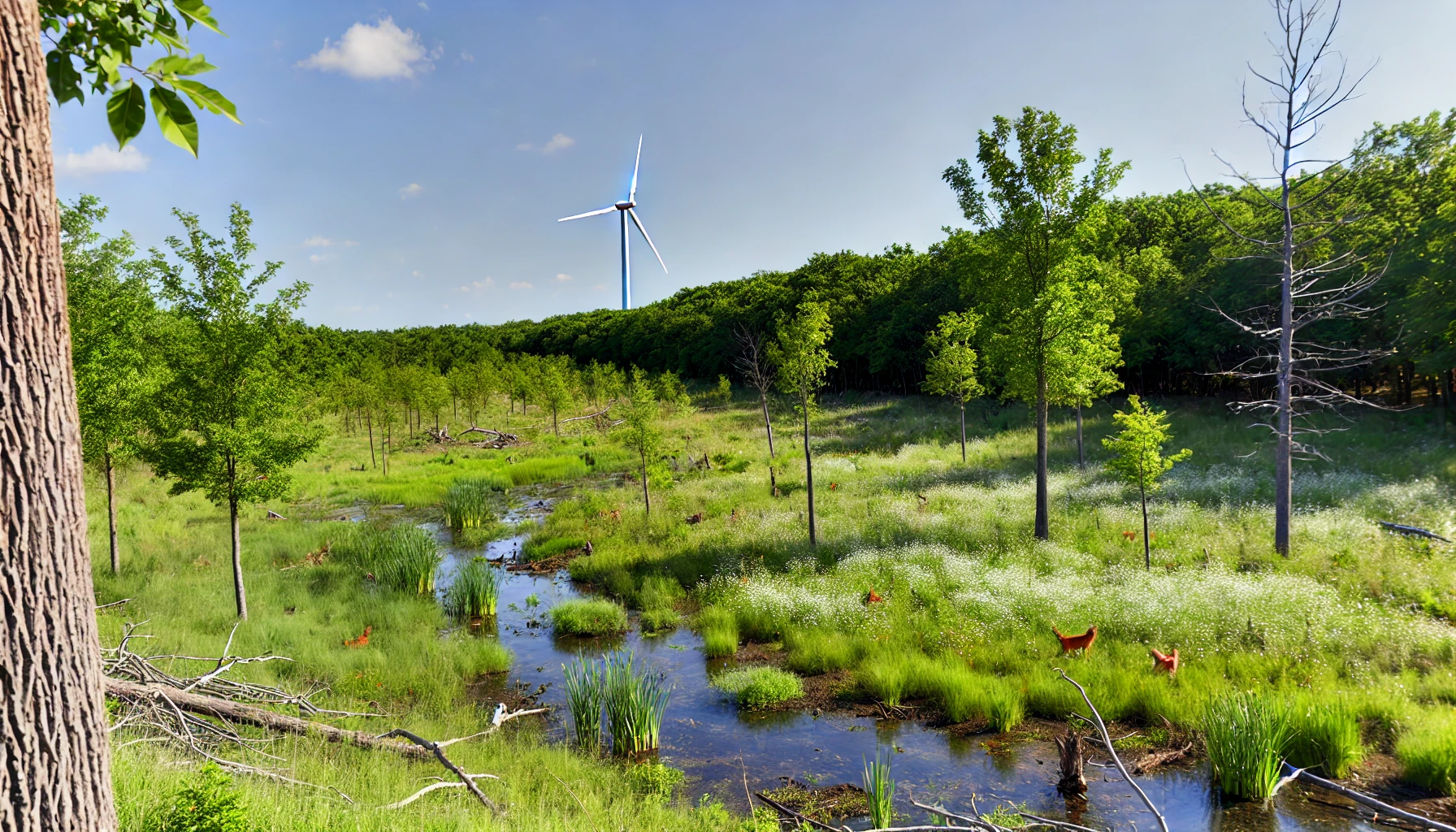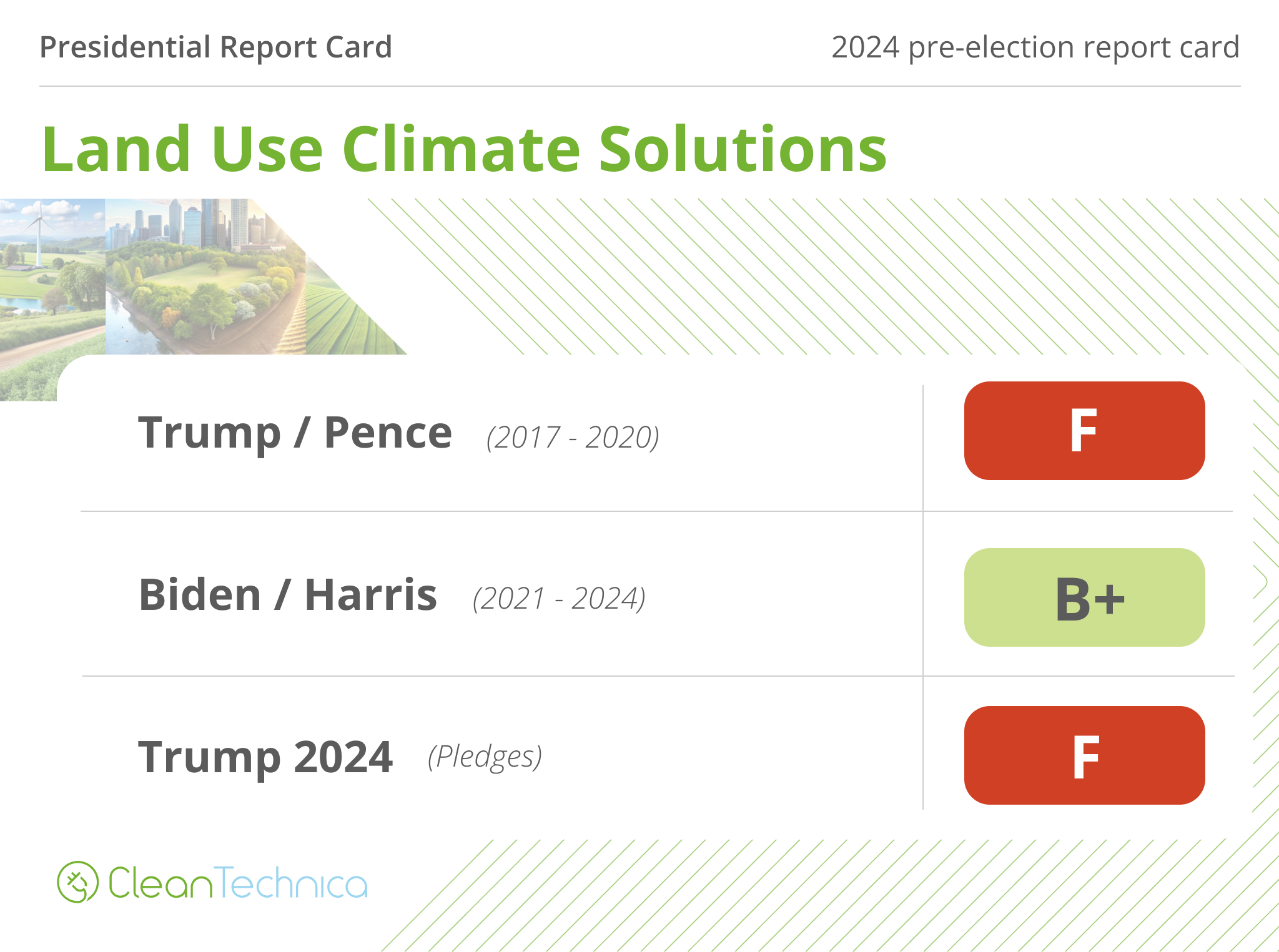US Election 2024: Land Use Climate Solutions Report Card
In the global fight against climate change, land use policies have emerged as a pivotal factor in reducing greenhouse gas emissions and enhancing community resilience. Urban planning that promotes compact, mixed-use development can significantly cut emissions from transportation by reducing the need for long commutes.

Forestry management and sustainable agricultural practices also play a vital role in carbon sequestration. Policies that protect and expand forests enhance their capacity as carbon sinks, capturing and storing carbon dioxide from the atmosphere. Sustainable forestry practices and reforestation efforts are key components of these strategies. Similarly, promoting agricultural practices such as no-till farming, cover cropping, and agroforestry can sequester carbon in soils and vegetation, while policies incentivizing these methods provide crucial support to farmers.
Resilience to climate impacts is another critical aspect of land use policies. Zoning regulations that restrict development in floodplains, coastal areas, and other high-risk zones reduce vulnerability to extreme weather events exacerbated by climate change. Integrating green infrastructure, such as parks, green roofs, and permeable surfaces, into urban planning not only manages stormwater but also mitigates urban heat islands and enhances biodiversity. Additionally, designating land for renewable energy projects and supporting dual-use land initiatives like agrivoltaics optimize land use, contributing to a sustainable transition to clean energy sources.
Effective land use planning requires a holistic approach that considers environmental, social, and economic factors. Coordination between land use policies and other climate-related policies, such as energy and transportation, is essential for maximizing their impact. Addressing issues of social equity ensures that marginalized communities are not disproportionately affected by climate impacts or excluded from the benefits of climate action.
The Biden–Harris administration has made strides in various land use policies, emphasizing reforestation, agricultural decarbonization, wetland and grassland restoration, and a shift in oil and gas lease management while promoting renewable energy projects. It is attempting to address a four-million-acre reforestation backlog on national forests, with a commitment to plant over one billion trees in the next decade and $100 million in funding. The administration has allocated $161 million for ecosystem restoration across 11 western states, focusing on projects that restore wetland meadows and wildlife habitats. These are small numbers in the context of a country the size of the USA, so are more aspirational than needle-shifting.
In the agricultural sector, more significant money is committed, over $3 billion designated for climate-smart practices in fiscal year 2024, encouraging methods such as cover cropping, conservation tillage, and nutrient management to reduce greenhouse gas emissions and improve soil health. Currently, the United States has several green ammonia fertilizer plants under development, with a few nearing operational status, but no large-scale commercial green ammonia fertilizer plants are fully operational yet.
A significant policy shift under the administration is the moratorium on new oil and gas leasing on federal lands and waters, which impacts about a quarter of the nation’s oil and gas production. This aligns with the broader goal of reducing carbon emissions and fostering a clean energy future. In tandem, nearly 29 gigawatts of clean energy projects have been permitted, surpassing initial targets and providing enough power for over 12 million homes. Furthermore, over 41 million acres of lands and waters have been conserved under the “America the Beautiful” initiative, with an ambitious target to protect 30% of U.S. lands and waters by 2030.
The Biden–Harris administration has established and funded the American Climate Corps. This initiative, launched in September 2023, aims to mobilize tens of thousands of young Americans for careers in clean energy, conservation, and climate resilience. The ACC is modeled after Franklin D. Roosevelt’s Civilian Conservation Corps and is designed to train and employ individuals in various climate-related fields. The program includes nearly 2,000 positions across 36 states, DC, and Puerto Rico, with a focus on creating pathways to good-paying, union jobs in the clean economy.
The Biden–Harris administration has taken a proactive stance in addressing coastal erosion and the planned retreat from areas most vulnerable to climate change impacts. Recognizing the increasing threats posed by rising sea levels and extreme weather events, the administration has implemented a series of initiatives aimed at bolstering coastal resilience and facilitating the relocation of communities at risk.
Central to these efforts is the administration’s commitment to enhancing natural coastal defenses. Through the National Coastal Resilience Fund, significant investments have been made to restore wetlands, dunes, and mangroves that act as natural buffers against storm surges and erosion. These projects not only protect coastal habitats but also enhance biodiversity and provide recreational opportunities, benefiting both the environment and local economies.
In addition to strengthening natural defenses, the Biden administration has emphasized the importance of managed retreat, a strategy involving the relocation of communities from high-risk areas. The Federal Emergency Management Agency (FEMA) has been instrumental in this effort, providing funding and technical assistance for voluntary buyout programs. These programs offer financial incentives for homeowners to move away from flood-prone regions, allowing for the restoration of these areas to their natural state, thereby reducing future risks.
Furthermore, the administration has prioritized updating and enforcing stringent building codes and land-use policies in vulnerable coastal zones. These measures aim to discourage new development in high-risk areas and promote the use of resilient infrastructure for existing developments. By integrating climate data into urban planning and zoning regulations, the administration seeks to ensure that future growth is sustainable and that communities are better prepared to withstand the impacts of climate change.
These actions are much stronger than the relatively light focus on land use the Biden–Harris campaign had indicated, and one of the places where campaign rhetoric was overshadowed by action during the administration. Barriers in this space were much lower, so more should have been expected of course.
Trump’s EPA during his administration focused on rolling back Obama-era land use decisions. Trump’s administration permitted oil exploration in the Arctic — although, no significant exploration occurred. It rolled back methane-emissions standards. It permitted mining, oil and gas extraction, and grazing on federally protected lands. Trump’s policies related to agriculture were mostly damaging to American farmers and environmentally harmful. They included the trade war with China, which required a bailout for farmers twice the size of the 2009 auto industry bailout, a grab-bag of efforts related to ethanol, which left farmers with lower revenues while doing nothing for climate change, and a rollback of Obama-era water safety regulations that farmers disliked.
Naturally, in 2024, Trump is promising to remove the moratorium on oil and gas leasing on federal lands. Further, he is expressing a desire for pushing for more single-family dwelling zoning in the countryside, the antithesis of a rational housing, economic, or urban strategy.
Have a tip for CleanTechnica? Want to advertise? Want to suggest a guest for our CleanTech Talk podcast? Contact us here.
Latest CleanTechnica.TV Videos

CleanTechnica uses affiliate links. See our policy here.
CleanTechnica's Comment Policy


